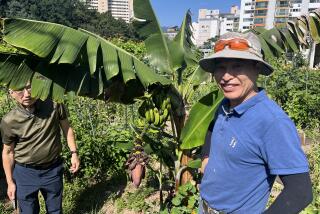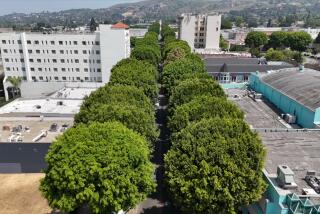Bamboo May Be Trendy, but It’s Not Beloved by All
After last Thursday’s report on how some privacy-starved Angelenos are planting giant timber and other big bamboos on their property lines, the questions and comments came.
Los Angeles real estate agent Jory Burton suggested that “each decade has an “in” screening plant. “The 1970s had the hideously ugly cypress tree, the ‘80s and ‘90s had the ficus, and now the new millennium has bamboo.”
Some didn’t like the idea at all. Joseph M. Hartley of Santa Monica wrote, “Next time you write about bamboo, you really need to talk to the neighbors about what unpleasant plants they actually are. Eight years ago our neighbors planted a stand of giant bamboo. Ever since then, I have had to clean out the gutters every three months.
“The sideyard next to the bamboo is impossible for growing because of the quantity of debris the bamboo drops. Ironically, as your article points out, the bamboo has very few leaves on the lower levels, so it provides no practical privacy. Good fences may make good neighbors, but a stand of bamboo does not.”
Some wanted to get rid of aggressive bamboo--planted by mistake or by some previous owner--that had run amok in the garden. Christine Tung, for example, recently purchased a house and “discovered in the spring after the rains that our entire backyard is infested and overrun by bamboo,” which is growing more than 60 feet into her yard. “And there are roots going under the concrete slab, and culms coming up between the pool coping and tile line. I am very worried about it ultimately getting into the house foundation and growing up in our living room.” Yikes!
Banishing bamboo from a garden was not covered in Thursday’s article. Although the American Bamboo Society is interested in getting people to plant bamboo, its Web page (https://www.bamboo.org/abs) does mention how to get rid of unwanted stands--by starving them.
To do so, cut the bamboo to the ground and then break off every new shoot or paint the new shoots with the herbicide Roundup. You can’t let plants make any new leaves or they will manufacture food for the roots and you will end up back to square one. The roots must also be severed from any existing stand--say, one in a neighbor’s yard--that might be supplying food.
This will also keep systemic herbicides such as Roundup from killing the neighbor’s bamboo. Keep at it, and in time the roots will die. Unfortunately there are no faster or easier solutions.
Some readers, like Dr. Ann E. Walts, wanted to know if they could grow bamboo in pots on a balcony or inside. Almost all small or mid-size bamboos do great in containers, especially some of the more rambunctious kinds that run amok in the ground, such as the running black bamboo, Phyllostachys nigra, or the common golden bamboo, P. aurea.
Planted in 18- to 24-inch-diameter pots, or in half wooden barrels, both bamboos make lovely upright screens for a patio or balcony. Growing in pots naturally dwarfs bamboo a bit, but if it gets too tall, simply prune off the top.
You can bring bamboo inside for an occasional visit, but it is an outdoor plant. Even outdoors, bamboo generally prefers growing in full sun, though there are kinds that tolerate shade, such as the small Himalayan blue bamboo (Himalayacalamus hookerianus).
*
Write to Robert Smaus, SoCal Living, Los Angeles Times, 202 W. 1st St., Los Angeles, CA 90012; fax to (213) 237-4712; or e-mail robert.smaus@latimes.com.






